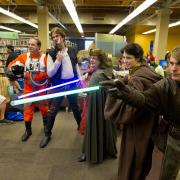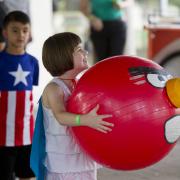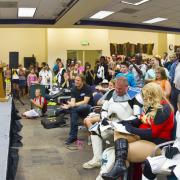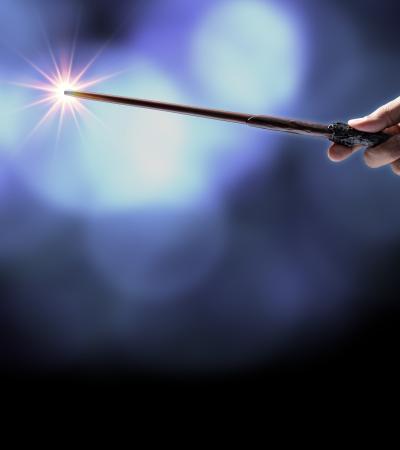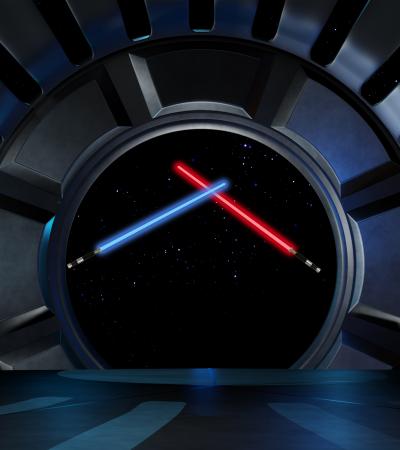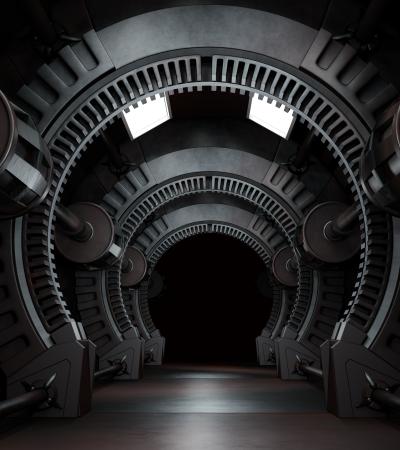MegaMania is an annual event that aims to bring educational aspects of comic book and cosplay culture to youth who may not otherwise have access to large comic cons. Though planned primarily for teens, people of all ages are welcome to attend and explore cosplay opportunities, gaming demonstrations, local author panels, art workshops and more.
The success of this event is made possible by partnerships with local businesses, artists, authors and creators, in addition to support from administrators and instructors from Pima Community College, where the event takes place.
Advanced Planning
The MegaMania planning team begins their one-year planning cycle by meeting with all library staff involved with Young Adult Services in PCPL. This generates new and exciting ideas and allows YA staff to be involved with the planning process. When event planning becomes more detail-oriented, the MegaMania team starts meeting monthly on its own. Tasks are assigned at these meetings, and each member of the committee is expected to follow through with responsibilities given.
The planning team comprises section leaders (“Ninjas”) along with two co-chairs of the team. There is one section leader for each area: cosplay, author/artist, gaming, crafts for kids and logistics. PCPL has found this to be an excellent way for library staff to gain leadership and event planning experience.
In recent years, librarians have been approached by youth interested in presenting at MegaMania. In 2015 and 2016 the event hosted programs including cosplay story time, presented by a high school student, and two different all-teen cosplay panels. MegaMania’s interest-driven mission encourages teens to take initiative and engage in the program in new and exciting ways.
Marketing
MegaMania co-chairs begin to work with the library’s graphic designer in April to generate promotional materials like fliers, bookmarks and posters for the event which is held in July. Each library in PCPL receives these and hands them out to teens and families.
Artwork is an important element of MegaMania’s publicity materials. In 2015 and 2016, a former Pima County Public Library employee was contracted to create designs that were consistent with the event’s themes, such as science and technology, art, writing, gaming and making. In past years, young adult librarians organized an annual teen art contest that awarded its winner the opportunity to create this work.
PCPL’s community relations manager is heavily involved in promoting and marketing the large event to local media outlets. She sends a press release to newspapers, television stations and local websites in late June. MegaMania planning staff have been featured on a local morning show for the past four years, and in 2016 the event had a front page feature in Tucson Weekly. In addition, blog posts promoted the event, including ones with Q&As with presenters Adam Yater and Adrienne Celt.
Promoting MegaMania to established library users is vital, but expanding the library’s reach can attract new patrons who may be unfamiliar with our services.
Budgeting
Over the last six years, MegaMania has been able to increase its annual budget from $1,000 to $7,000 due to the program’s growth coupled with the prominent role it plays in the library’s summer learning program. These funds are spent primarily on:
- New gaming equipment, including strategy games, board games, video games, consoles and accessories.
- Book purchases. The library purchases books written by author participants in exchange for their time. Authors sign and give their books out to audience members for free.
- Food and water. Thanks to a helpful partnership with a local pizzeria, the library receives pizza for everyone at the event at 75 percent off. Water bottles are also provided due to extreme July heat in Arizona.
- Fabric and costuming supplies. MegaMania is a unique event because cosplay section staff help teens sew their costumes. Fabric and accessories are purchased in advance for this purpose.
Partnerships with local businesses (bookstores, restaurants, etc.) can be extremely helpful when working with a smaller budget. Don’t be afraid to ask for discounts or freebies — your local businesses love the library. If you have any Friends groups or other non-profits that work directly with the library, think of ways you can work together.
Day-of-event Activity
MegaMania is a four-hour long program with a variety of stations and activities (see the full schedule here). Staff at all levels are encouraged to work and experience this exciting systemwide event.
Ninjas work full eight-hour shifts to oversee their particular areas, while staff who are not involved with planning typically work four-hour shifts throughout the day. It is critical to schedule enough staff for set-up and clean-up. Section leaders identify a number of helpers they need throughout the day, and staff are scheduled accordingly. Each person receives an assignment card with their hourly schedule.
Challenges MegaMania organizers have faced in past years include no-show staff and volunteers, technology problems, venue restrictions and staff shortages. The ideal number of staff and volunteers to run an event as large as MegaMania is 40, but this was slashed to 20 in 2015 due to budget problems. This reduction in staff was stressful, but meticulous pre-planning helped it run smoothly.
Planning ahead is crucial to the success of any large event. Event organizers deliver materials to the venue the evening before so that there’s ample time to prepare each area the next morning.
Program Execution
MegaMania attendance has steadily grown over the last six years. In 2010, we had just under 500 attendees. In 2016, there were roughly 1,200. Despite last-minute changes and challenges, each year comes with new successes. Thanks to flexible staff who can always find creative solutions to problems, unexpected obstacles become triumphs and learning experiences.
If families and teens at MegaMania have a great time every year — while learning new skills and making new connections — the team has achieved its goals.
Advice
Start small. Define your mission and figure out what purpose you want your event to serve. After that, think of a small number of activities that tie in with your mission. Don’t try to organize a program meant for thousands of people your first year. Select a team full of people interested in working with young adults and brainstorm new ideas that would excite your community.

